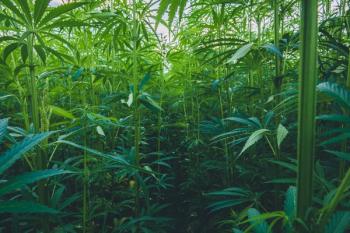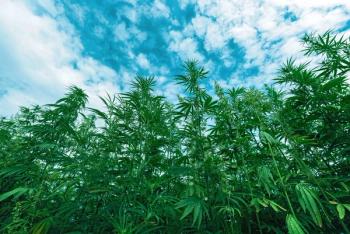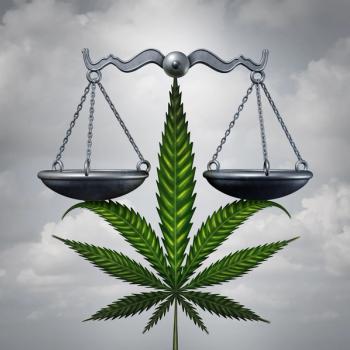
Characterizing Cannabis
An interview with Jeffrey C. Raber
For a long time, tetrahydrocannabinol (THC) was the primary compound discussed as an “active” ingredient in cannabis. In recent years, however, researchers have
characterized many other compounds in cannabis, such as other cannabinoids and terpenes, and efforts are being made to create profiles of different cannabis strains. Jeffrey Raber is the CEO of The Werc Shop, an independent analytical testing laboratory working on cannabis, and is focused on advancing cannabis characterization. He spoke to us about that work.
An important focus of your work in cannabis analysis is the terpene fingerprinting of cannabinoids. How did you get started with that work?
Toward the end of 2010 we started to see that if you analyzed cannabinoid profile in two different cannabis strains, you might see almost identical cannabinoid chromatograms for both. Yet you were holding two things that are very different morphologically and in smell. And even users can tell that different strains cause very different physiological effects. So we knew there was something other than the cannabinoids that was physiologically active or imparting some of that response. We decided that the best place to start would be to look at the terpenes. We started that work in the middle of 2011. And when you analyze the terpenes, you start to see that that’s where a lot of the chemical variability among the plants really lies.
How many different terpenes have been identified so far?
I believe it is currently accepted that there are around 120 or more different terpenes in the cannabis plant. When we first started looking, we analyzed about 35. Since then we’ve developed methods to look for more, and are now routinely analyzing about 80.
What methods are you using to analyze terpenes?
For routine quantification, we use gas chromatography with flame ionization detection (GC–FID) methods that are pretty straightforward. But we have used GC with mass spectrometry detection (GC–MS ) to help identify some compounds; you can get known standards to confirm the identifications. It’s just a long and laborious process.
Are there any problems with getting standards?
No, other than that you cannot get them all in one place. There’s no issue with cannabinoid standards either. They are all 1 mg/mL or less and they are able to be shipped to people without a Drug Enforcement Administration (DEA ) license. So, they’re readily available to analytical labs.
Are standards available for all of the 120 established terpenes?
I do not believe standards are available for all of the terpenes found in cannabis, but standards are available for many of them. Many are only available individually but one supplier has a combination of around 30 in a single standard.
I think most states are now starting to require that cannabis products be tested for the terpenes listed in the American Herbal Pharmacopeia (AHP) monograph (1); I believe it lists around 12. Those are the terpenes that are most commonly present in all strains and the ones probably most useful to most people for furthering their cannabis product understanding today. I think most labs are initially focusing on analyzing those.
What is the goal of your terpene fingerprinting work?
Our first goal is to understand the composition of the cannabis product, and second, to help move toward standardization. If we understand plant composition, that can help cultivators produce the same product time and time again, which is an extremely important starting point for patients to be able to start to rely on medical cannabis-to ensure they get the same therapeutic effects consistently. It goes further to other cannabis products, such as concentrates. We want to understand the exact composition of these products so that we can understand exactly what people are consuming and how the physiological effects may relate to those compositions.
This work can lead toward a classification and naming system for cannabis strains, based on a chemotyping methodology. That would allow us to have a dialogue about how certain types of cannabis should impact certain types of patients in certain ways based on what we’ve seen collectively. What’s currently happening is a lot of misidentification, a lot of misnaming, a lot of misunderstanding, unfortunately. A lot of “misses,” I guess you could say. It’s not a very pretty picture. Today, we have patients who walk into a dispensary and say, “I have problems with insomnia. I would like to find something that will help me sleep.” And the current mind-set is to respond by saying, “Well, why don’t I just tell you to pick an indica variety (Cannabis sativa L. ssp. indica) because indica will make you feel sleepy, unlike sativa (Cannabis sativa L. ssp. sativa), which will make you feel awake.” But that’s absolutely not the case. Indica and sativa are morphological designations of the plant, related to how long the plant takes to flower or go through its harvest cycle. They are not an indication of what physiological response will arise from consuming that particular plant as those designations don’t depict the chemical compositions specifically.
Only by understanding the chemical compositions of different varieties of cannabis and cannabis products will we be able to start to have a better dialogue between patients and doctors and figure out how to best utilize this medicine.
For any clinical studies of medical cannabis that are being done, isn’t this lack of characterization an important limitation?
Yes, the current environment is pretty devoid of a solid analysis of the composition of cannabis products. For example, in some clinical studies done in California, they only reported the THC value of the cannabis. They didn’t say what terpenes were present, or what other minor cannabinoids might be there. I am not even sure if they administered the same strain every single time.
And there have been other studies that ask people about their experiences with cannabis, but they don’t ask which cannabis. Different strains can have widely different effects. How is it accurate to say “cannabis helps with this ailment”? Shouldn’t they say which strain or which cannabis with what specific profile? Past studies have been frustrating; they may have said that cannabis administered had 4% THC, 8% THC, and 12% THC. Was it all the same strain? And what were the ratios of the other ingredients in them, such as terpenes? Was it really an exact dose or was it really different medicines? It’s hard to know. The cannabis used in those studies may have been fairly consistent across samples because it was most likely coming from the same source, but you can’t always guarantee that as it wasn’t clearly specified.
We’re finally going to see at least an improved study for the use of cannabis in post-traumatic stress disorder (PTSD). It’s about to get started and will use a couple of different strains-one high in THC, one high in cannabidiol (CBD), and then a strain (or mixture of the two) which has a one-to-one THC:CBD ratio. But even in this case, they are most likely not fully classifying the strains chemically or really describing the terpenes. We’re not getting enough rich chemical composition information to really understand everything that is going on when patients take cannabis as medicine.
This lack of rich information points back to the need for a common language to fully describe the profile of cannabis. That would allow research scientists and everyone involved to talk about the products the same the way, across the board. Then we can make real progress.
How do you create a common language?
First, as I mentioned above, we have to understand how many different compounds we’re talking about and characterize the strains fully.
But the other challenge is that doing that may upset those who thought that they had something special who then find out the hard way that they don’t. Some cultivators have probably paid a significant amount of money for access to some of the strains they’ve obtained. Some people will jump up and down and swear that they are the ones with a particular strain of cannabis that has a particular value attached to a specific name. It’s a challenge to tell them that that may not be the case. And we’re not trying to harm or hurt anybody. We’re just trying to create a common language that everybody can use without confusion so we can better utilize the plant.
And in creating that language, or classification system, we need to think about how many different compounds we need to talk about and how they then cluster through chemotyping analysis. And we want to have space in the classification system for new compositions that have not yet been identified or characterized. But we also have to try to keep it as simple as we can. It’s probably easy to greatly overcomplicate it. So, we’re talking with everybody to try to figure out a way to develop a system that everyone will adopt easily.
I believe you only get one chance to do that. If you don’t do it right and if no one likes it, it’s going to have to be redone and then you’ve missed your opportunity. So we’re not anxious to hurry and do it the wrong way. We’re taking the time to try to really think it all the way through. It’s much more complex than I thought when I first started.
What types of samples are you analyzing, and what sample preparation or sample extraction methods are you using?
The samples are mainly dried leaf and flower, because that’s what most people consume. We also analyze concentrates and extracts.
For sample preparation, we take the approach that “less is more,” because most of the compounds of interest sit on the outside of the flower or are held in trichomes that sit right on the outside of the plant material. It’s not hard to collect them; you don’t have to beat up the sample or do a lot to prepare it. You basically just have to extract it simply, filter it to make sure you’re not going to clog your liquid chromatography (LC) or GC instrument, and then inject it. It’s really very minimal sample prep.
The trickiest part is ensuring that you’ve got a representative and homogenous sample; actually collecting the sample is probably one of the most important steps in getting good analytical data, especially when working with this plant, where you’ve got lots of variability due to cultivation conditions. The top of the plant may be producing 20% THC in the form of THC acid (THCA), while the bottom may be producing only 10%. So, if you’re grabbing the flower from the bottom of that plant, you’re going to think that it didn’t produce nearly as much THC as it actually did. So, it’s very important to get a representative sample across the entire plant or the entire batch. I think that’s where a lot of inaccuracies stem from.
Concentrate is a lot easier, but it can have the same problem: Sometimes it can be what we call “layered,” where you have striations that have a small difference in concentrations. So you want to make sure that the concentrate sample is really well mixed and homogenous.
Are you also doing analyses for various types of contaminants?
Testing for contaminants is very important to protect the public. So, yes, we have to test for what we call cultivating agents, a broad term that includes pesticides, herbicides, rodenticides, and fungicides. We also have to test for microbiological contaminants. All of these might be present on the plant material, or may come from handling and poor hand washing. These types of contaminants are especially important when you’re talking about medicine for immunocompromised populations.
What challenges have you have faced in the analysis of cultivating agents?
It’s a big cat-and-mouse game. If you start to say you’re looking for a certain compound, the cultivators may use other compounds. It’s also very challenging to detect compounds at low levels. If you are saying that you have found a certain pesticide or a plant growth regulator, you want to be sure you are accurate, because you’re talking about jeopardizing someone’s livelihood if you’re wrong. And at the same time, if you miss something, people will get exposed to those compounds. So you don’t want to be wrong either way.
And when you are analyzing for cultivating agents in cannabis, the matrix is a big challenge and it is always changing. You may be throwing a whole bunch of THC or THCA at your MS detector in one sample, but the next sample may have none of that and instead may have a lot of CBD and CBD acid (CBDA). So then it’s a very different haystack that you’re looking for the same needles in. Sometimes it takes a little bit of tuning and close attention and a lot of confirming and revalidating what you thought you saw. It’s a big challenge.
And state regulators don’t know what they’re asking you. They say, “Find all the pesticides.” That means looking for thousands of molecules. That’s not going to work. If we ask them to give us a ballpark or a reasonable number to start with, they say “We don’t know. You tell us.”
The dialogue has been evolving, however. Now they are starting to tell cultivators that they should not use anything other than certain types of agents on their crops. But that still doesn’t make the analytical problem easy. Does that mean we have to look for everything else but those approved compounds, or are we supposed to look for those approved compounds plus everything else? Are there compounds that are absolutely excluded? And then, are there limits that I should be checking them against?
And there is no solid understanding of allowable daily intake limits, especially when you’re talking about an inhalable product. It’s really uncharted territory and a lot of research needs to be done. I think you can say, “I know that this cultivating agent is allowed on lettuce and we eat about this much of it a day. But how different is that if I’m going to inhale it? And what am I actually getting exposed to when I inhale it via combustion or vaporization?” Those processes may produce very different chemicals that ultimately have very different toxicological profiles.
What about other potential contaminants?
Some labs are getting started on the analysis of mycotoxins and aflatoxins, but we are not doing that work ourselves.
In our lab, we use rapid microculture techniques to try to determine which classes of pathogens may be present. We conduct tests for total aerobic count, enterobacteria with coliforms, and combined yeast and mold counts. So far, we’ve just been looking for colonyforming units per gram, but it’s starting to move toward specific organisms, particularly for nasty players like salmonella, pseudomonas, listeria, E. coli, and so on.
And in addition to pesticides, bacteria, and microbiological contaminants, another concern is residual solvents in the concentrates. Those are probably the three main classes that everybody is looking at.
The next step is heavy metals. I don’t think anybody has any idea what quantities of heavy metals should be there or could be there. It is pretty well understood that cannabis can be a remediator of metals from the soil so it’s reasonable to assume that it is going to pull them up if they’re in the soil. But do those metals reach the flower, or are they only in the leaf, or do they stay in the root? How much is here, how much do we worry about, and what limits do we set for labs to test for on the inputs? Unfortunately, none of that information exists either.
Do your customers understand all the testing you do?
It can be a problem when you find contaminants in a voluntary testing market. This is the only job on the planet that you could do really well and lose all your clients. Because no one is anxious to submit samples to find out if they are contaminated. I’ve had operators who have told me directly, “You guys are fantastic at your lab testing. But I’m not going to use you until I have to because I don’t want to be left holding the bag.”
That was disappointing and disturbing to hear. It gives you a view into the mindset of some of the operators today. But I believe that that’s changing. If the regulators say they have to do certain testing, then people will get on board and do it. If you start to require that operators obtain a license, they start to learn to be professional and above board; the mentality certainly starts to change when people have something, like a license, to lose.
Some people developing analytical methods for cannabis have had trouble obtaining real samples, and have worked on surrogates. Do you think that can be effective?
It’s challenging, because it’s only a surrogate; it’s not the exact thing that you want to analyze. So, there are certainly models that you could use to train yourself, but if you were to train yourself by looking for pesticides in hops, you’re going to have a rude awakening when you start analyzing cannabis. They’re just not the same matrix.
This problem comes up a lot in ring tests [round-robin proficiency tests], when state restrictions prevent a real sample from being sent to some labs. I think the states are going to start to require proficiency tests on real samples because they’ve realized in the absence of that, you could ask a lab to be ISO certified and it still doesn’t tell you if they can get the analysis right. It tells you that they can do a method repeatedly, but they could also do the wrong thing repeatedly and the ISO certification process may not reveal that. In other words, how do we know that they’re actually accurate, not just precise? That only comes through a proficiency test. So I think that states are going to start to set up systems where anyone providing lab services in that state is going to have to pass proficiency tests with real samples.
That’s going to take a little while, but I’m glad to see that it’s starting to go in the right direction. So I’m optimistic that it’s going to get better.
Jeffrey C. Raber received his Ph.D. in Chemistry from the University of Southern California with a focus on developing new synthetic organic methodologies. Upon receipt of his degree from USC, Raber joined a start-up company as the director of product development, where he created new molecular scaffolds for use as starting points in the investigation of new pharmaceuticals by medicinal chemists and successfully transferred proprietary reaction methodology and know-how to a production partner. He subsequently joined another start-up company focusing on development and commercialization of a novel chemical reactor technology. In 2010, having recognized a need for quality control and assurance in California’s Medical Cannabis arena, Raber founded The Werc Shop as an independent analytical testing laboratory to provide services related to medical cannabis.
Disclosures:
This article was originally published in "Advancing The Science of Medical Cannabis," e-book for LCGC in September 2016. The full e-book is available for download here:
References:
- Cannabis Influorescence Therapeutic Compendium (American Herbal Pharmacopoeia, Scotts Valley, California, 2013).
Newsletter
Unlock the latest breakthroughs in cannabis science—subscribe now to get expert insights, research, and industry updates delivered to your inbox.





